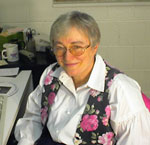-
About Us
Keith J. Stine, Chair
Mission Statement
Degree Offerings
Department Photos
Outreach Activities
-
Undergraduate Studies
Undergraduate Degrees
Undergraduate Program Advising
Undergraduate Scholarships and Awards
Research for Undergraduates
Resources
-
Graduate Studies
Graduate Program Overview
Graduate Degrees
Application to Graduate Program
Graduate Awards
Graduate Program Contact Information
-
Faculty
Faculty Contact Information
Inorganic
Organic
Analytical/Physical
Biochemistry
Chemistry Faculty Awards
-
Staff
-
Seminar Programs
Archive
Graduate Student Seminars
Robert W. Murray Lecture
Distinguished Alumni Lecture
-
Departmental News
News Archive
-
Facilities
High Field NMR Facility
MIST Lab
X-Ray Diffraction Facility
-
Alumni Interests
UMSL Chemists
Important Dates
Distinguished Alumni
Alumni Lecturers
-
Contact Information
|
|
Professor Corey received her Ph.D. degree at the University of Wisconsin following a B.S. and M.S. at the University of North Dakota. She has held visiting faculty positions at the University of Wisconsin, and the Universite des Sciences et Techniques du Languedoc. She has been at UMSL since 1968 and became Professor Emerita in 2008. |
corey@umsl.edu |
Research Interests
Unlike CH bonds in hydrocarbon chemistry, the SiH bond in hydrosilanes may be viewed as a functional group. However, transformations of SiH to other Si-element bonds usually require a catalyst. Typical coreactants are HE1 species and if E1 represents another silicon unit, then homodehydrocoupling occurs to give silicon oligomers and polymers with H2 as the only by-product. Titanium triad complexes are particularly effective for this transformation. Silicon analogs of substituted ethanes, propanes and butanes can be formed through the reaction of secondary silanes such as PhMeSiH2 in the presence of the combination, Cp2MCl2 (M = Ti, Zr, Hf) and n-BuLi. With the availability of this simple dehydrogenative coupling reaction, the chemistry of short chains can be studied and developed. Examples include the removal of phenyl groups in H(PhMeSi)xH with l to x equivalents of triflic acid to give the corresponding silyl triflates, H[(Ph)x-y(OTf)ySixMex]H. Replacement of the triflate group by reaction with a number of nucleophiles may then take place to provide new oligomers. Oligomers with fluorosilane end groups have also been prepared through reaction with CuF2 or CuCl2/KF/KI.
Condensation of primary silanes with metallocene halides plus RLi provides polysilanes whose molecular weights vary with the structure of the metallocene. The mechanism for this condensation process is not entirely clear but probably involves sigma-bond materials steps and possibly radical processes. Strategies that will lead to an increase in molecular weight are under study and include modification of the basic metallocene structure as well as the development of new catalyst systems. Although earlier reports suggested that syndiotactic polysilanes were produced from metallocene catalysts, our recent studies have demonstrated that this is not the case and that the polymers are atactic. New challenges are to find catalysts that improve the molecular weights and control the microstructure of the polymer. Dehydrocoupling has also been utilized to generate polystannanes from hydrostannanes as well as carbosilanes from systems of the general formula, H3Si-X-SiH3.
The general reaction of hydrosilanes with other H-element bonds is a general process promoted by a variety of transition metals. This transformation proceeds by a mechanism that differs from the nucleophilic processes at SiCl bonds that are usually employed for substitution at silicon. As an example, hydrosilanes couple with alcohols in the presence of Cp2TiCl2/n-BuLi. In the presence of transition metal complexes hydrosilanes are also useful reducing agents for organic substrates. An example includes hydrosilylation of ketones that can be promoted in the presence of Cp2TiF2
Selected publications
″Reactions of Hydrosilanes with Transition Metal Complexes,″ J. Y. Corey, Chem. Rev. 2016, 116, 11291.
″Synthesis of Siloles (and Germoles) that Exhibit the AIE Effect,″ J. Y. Corey, In Aggregation-Induced Emission: Fundamentals; Qin, A., Tang, B. Z., Eds. Wiley, Chichester, United Kingdom, 2014, Chap. 1, 1-38.
"Siloles: part 1: synthesis, characterization, and applications," J. Y. Corey, Adv. Organomet. Chem. 2011, 59, 1.
"Siloles: part 2: silaindenes (benzosiloles) and silafluorenes (dibenzosiloles): synthesis, characterization, and applications," J. Y. Corey, Adv. Organomet. Chem. 2011, 59, 181
"Reactions of hydrosilanes with Transition Metal complexes and characterization of the Products", J. Y. Corey, Chem. Rev. 2011, 111, 863
"Reactions of (Et2CH2CH2NEt2).H2SiCl2 with Selected Diorganometallic Reagents of Magnesium and Lithium", J. Y. Corey, K. A. Trankler, J. Braddock-Wilking and N. P. Rath, Organometallics 2010, 29, 5708
